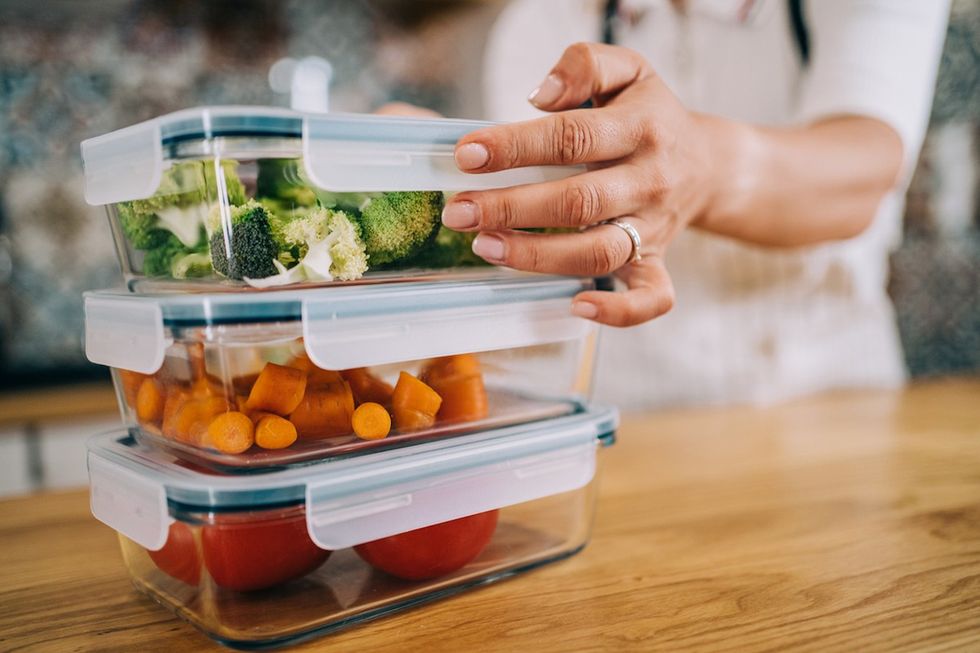Meal prepping is one of the most effective ways to ensure you stick to a healthy, nourishing diet during the week. “With anything in life, if you fail to plan, you plan to fail. That applies to meal planning as well,” registered dietitian Silvia Veri tells Corewell Health. “Planning meals and snacks ahead of time increases the chance for success, it increases the likelihood a healthier food choice will be made.” Here’s how to get started and get the most out of your meal prepping without feeling overwhelmed.
RELATED: The 10 Best Meal Prep Containers.
Get Food Containers
iStock
Get a variety of containers (preferably glass) for your food prepping. “I recommend choosing containers that are microwave-safe for hot lunches,” registered dietitian Elyse Homan, MS, RD, LD, tells the Cleveland Clinic. “Mason jar salads are also a good way to help ingredients stay fresh for several days in the fridge. You can freeze soups and chilis in smaller containers so you only have to heat up what you’ll eat for the week, and you can also portion out ingredients for smoothies ahead of time.”
Choose Your Food Prep Day and Meal
Shutterstock
Choose a day to focus on your food prep and make sure it’s a day where you have hours to devote to it, Homan says, then choose one meal to prep. “Choose one meal you struggle to eat healthy the most,” she says. “If you’re always on the go in the morning, save time by having breakfasts prepped for the week. If evenings are hectic with after work or school activities, have several dinners ready in advance.”
Stick To What You Know (For Now)
Shutterstock
Now is not the time to start experimenting with intimidating new recipes—stick to what you know until you’re more comfortable with food prepping. “Flip through cookbooks or online sites and find recipes that appeal to you,” says Barbara Gordon, RDN, LD, via EatRight.org. “Evaluate the level of cooking skill required to make the recipe. Do you have those skills? If not, are you up for the challenge? Also, make sure you have any special cooking utensils or pans needed for the recipe.”
Make a Grocery List
Shutterstock
Do not wing it—choose recipes you’re comfortable with and then hit the store fully organized. “You don’t have to make everything from scratch,” Homan says. “Buying a rotisserie chicken, tuna packets or a veggie tray can cut down on time. You can save money by portioning things out yourself instead. Make sure you have small, condiment- and snack-sized containers on hand to store things like salad dressing, trail mix and dips, like hummus and guac.”
Eat the Same Things

It’s perfectly acceptable to eat the same things for meals if that’s what you want. “It’s OK to have oatmeal or low-fat yogurt with berries several times a week for breakfast. The same goes for lunch; pick a few options and rotate them across a week,” Gordon says. “Jot down breakfast, lunch and dinner options. And, don’t forget about snacks.
Keep An Eye On Deals
Shutterstock
Keep track of any deals your local supermarket offers to save money. “Sometimes a discounted price can allow you to treat yourself and your family to a special meal,” Gordon says. “Remember: produce that is in season tends to be less expensive.”
Make It Fun and Get To Work
Shutterstock
You’ll be surprised at how fast you will get through meal prep when you’re listening to music, a podcast, or an audiobook. “Prep food individually, like washing and chopping veggies for the week that can be used in a variety of recipes or as a snack with dip,” Homan says.






